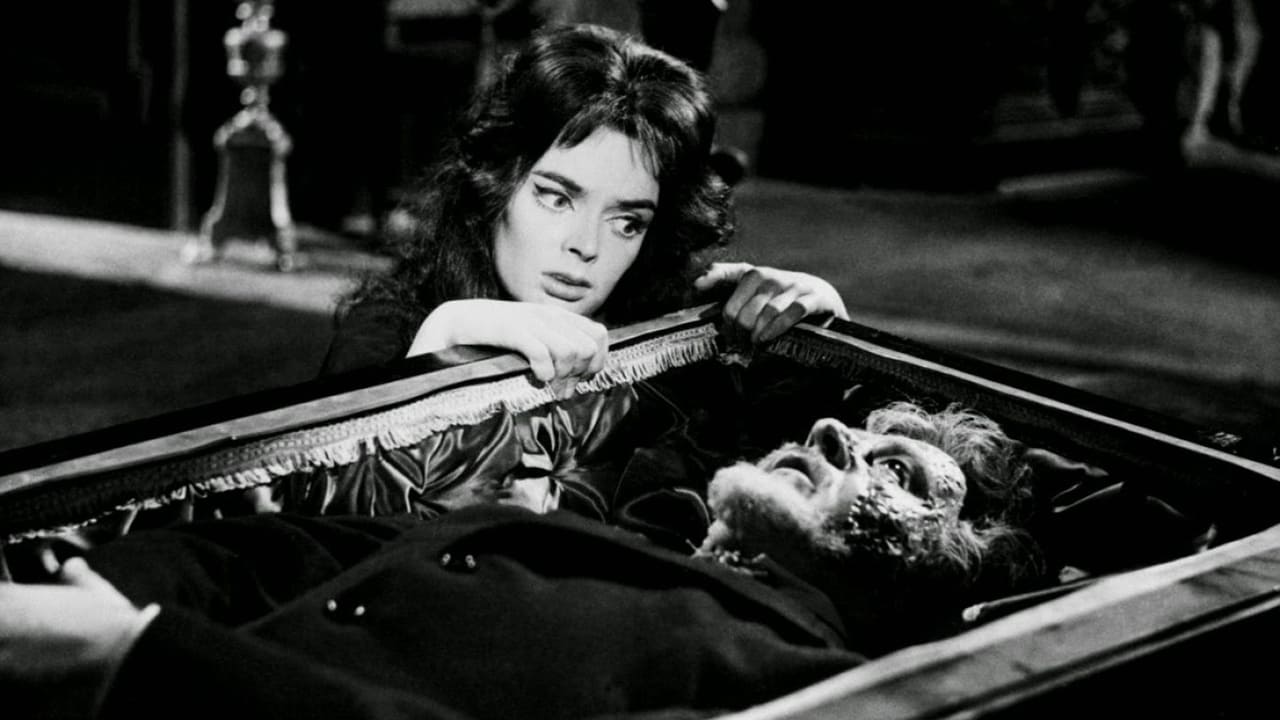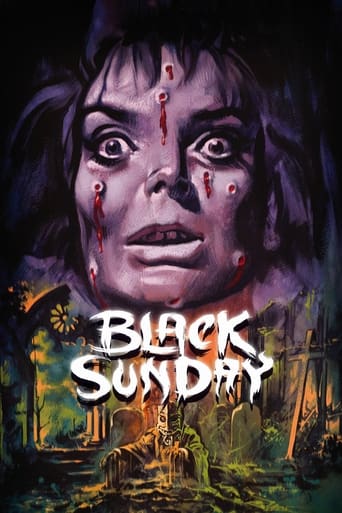

This has long been considered to be Mario Bava's best film and it's easy to see why. As a film, this stands as a milestone in the horror genre, helping to inspire countless others (THE LONG HAIR OF DEATH for example) which flooded the industry in the following years. In fact, I enjoyed a lot of them also, some even more so than this film, but there's no denying the status that this holds as a classic of the genre. The Italian director was renowned for his startling photography and his films were always incredibly atmospheric.The film is light years ahead of contemporary foreign production in its use of camera-work and sets to create an unnerving Gothic atmosphere and an almost fairy-tale like fantasy involving witches and the dead coming back to life. In a way the film is also very old fashioned, almost reminiscent of the Universal gothics, such as FRANKENSTEIN, but with extra gore thrown in. As Bava filmed the picture in black and white he was able to challenge the boundaries of screen taste, and images where nails are hammered into eyeballs are extremely graphic for the time. Remember this was 1960, eleven years before Bava again pushed the boundaries of taste in his classic giallo film A BAY OF BLOOD.The acting is also very high class for a production of this kind. John Richardson (star of Hammer's SHE) is a fairly typical hero for the time, with jutting jaw and a sense of wholesomeness about him. Checchi is also very believable in his portrayal of the doctor who becomes a murderous slave, as are the actors playing the priest and the male apparition. However, stealing the limelight was a young British girl called Barbara Steele, acting for the first time in a horror film. Steele is unforgettable, her face will stay with you a long time after seeing this film and she copes admirably with a dual role (not an easy task, especially when one of the characters is utterly good and the other utterly evil). Steele was successful in her role and afterwards starred in a high number of Gothic masterpieces like this one, although sadly she has turned her back on the genre in recent years.What else do we have? An unsettling score and a hundred and one Gothic images composed on screen. In this nether world where the dead walk among the living, we have haunted castles with secret passages, spooky figures wreathed in mist, deserted graveyards with overgrown weeds, a couple of characters opening up a coffin and finding a horrible creature inside, bats, and even wolves howling in the background. And, of course, the powerful witch-burning opening which was also highly influential at the time. As you may be able to tell I loved this film a lot, as it holds everything that I could possibly want from a horror movie. It's like a Hammer movie but even better in that it's spookier and more powerful. If you like your films Gothic and atmospheric then this occasionally quaint but still chilling item just may be for you.
... View MoreBlack Sunday (1960)*** 1/2 (out of 4) Mario Bava's classic features Barbara Steele in the role of a witch who is put to a violent death but before that she places a curse on the people killing her. Flash forward two hundred years as the witch is released from her tomb and sets off for vengeance.BLACK Sunday, also known as THE MASK OF Satan, has been released in various versions over the years but once you see it uncut you'll understand why it was cut! I say that because the film was quite shocking for 1960 and it's easy to see why so many people were terrified of it when it was released so seeing the uncut version would have probably led to some real nightmares. This Bava classic can be enjoyed today in its uncut version and it's certainly a beautiful film to look at with some of the most iconic images in horror history.Of course, the most famous image happens at the start of the picture when Steele gets a large spiked mask hammered into her face. Even after all these years there's no doubt that this sequence still packs a nice little punch. What I've always loved most about the picture is its incredibly dark atmosphere that Bava paints with some masterful cinematography and of course his use of shadow and fog. As you watch this movie you can't help but feel as if you're actually in the real locations and that you're surrounded by the various evil forces that are at play.It also doesn't hurt that you've got some very good performances throughout the film with of course Steele leading the way. Her look perfectly captures the evilness of the main character but she also does a fine job in her other role. The two characters are so different yet the actress perfectly pulls them off. The film also benefits from a strong music score, which helps push that atmosphere. BLACK Sunday has been copied many times over the years but it's yet to be matched.
... View MoreA vengeful witch (Barbara Steele) and her fiendish servant return from the grave and begin a bloody campaign to possess the body of the witch's beautiful look-alike descendant (also Barbara Steele). Only the girl's brother and a handsome doctor stand in her way.For many years I kept putting off seeing this because I was not sure if i had seen it or not, getting it confused with "Black Sabbath" (which it really has nothing in common with). Now I have seen the Kino version that is on Netflix. From what I understand, there are two English versions and an Italian one. I am not sure which one of the English ones this is (though the dubbing is funny given that Steele does not speak Italian).Anyway, beautiful film with some good black and white photography. I definitely need to see it again in its various versions before really making any serious comments.
... View MoreWhen "La maschera del demonio" was released in 1960, cinemas displayed a warning to those who could be affected by its strong images, right from the first sequence when Asa, a Moldavian witch or noble ascent, is sentenced to death by the Inquisition, and the title mask is nailed to her smooth, peculiarly beautiful face, with big eyes, high cheekbones, and fleshy lips. Director Mario Bava, who for the first time was in complete control of a motion picture, was subtle and graphic at the same time, in this adaptation of Nikolai Gogol-s long tale "Viy". A reading of the source against a screening of the motion picture would reveal the resorts of film adaptations: for a more faithful version, one should see the Soviet film "Viy" (1967). But the writers of "La maschera del demonio" opted for distancing from the original, and the result was an autonomous product, that still had potent echoes of Gogol's story, illustrated by two examples: one, the ominous vacation trip of the seminarists in the original, becomes the fateful journey of Dr. Kruvajan and his young assistant, Dr. Gorobec, key figures in Asa's resurrection; and two, Gogol's passage of a young novice who kills a witch in a cemetery, is reworked in three lines of action: a girl reluctantly milks a cow in a stable adjacent to the town's graveyard, where simultaneously Javutich (Asa's cousin, lover, and assistant) is raising from his grave, and not too far Dr. Kruvajan is picked up by a ghostly carriage to take him back to Asa's crypt. Moreover, the dead witch —who in "Viy" is first killed in the cemetery and later turns out to be a landowner's dead daughter— has accordingly a dual visual resonance: the face of witch Asa is the same as Katja's, daughter of one of Asa's relatives, both played by British actress Barbara Steele. Other resources and images are strictly Bava's: Asa's dead, wax-like visage, intact for centuries, except for empty eye-sockets; Katja's first appearance with a black mastiff, her languid expression as Asa vampirizes her with a touch, or the revelation of Asa's putrid body... Bava was also his own cinematographer (assisted by Ubaldo Terzano), excelling himself with striking, Gothic, black and white images; and the film was cut by classic film editor Mario Serandrei, who also contributed to the script. Roberto Nicolosi's score is effective in general terms, with the possible exception of the piano romantic theme, which sounds too contemporary for the visuals. (When the film was bought by American International Pictures for distribution in the United States, Les Baxter wrote a new score). Besides Steele (who was immediately crowned Queen of Horror) and British leading man John Richardson as Katja's suitor, Dr. Gorobec, three prestigious Italian character actors completed the main cast: Andrea Checchi as Dr. Kruvajan; Ivo Garrani as both the Inquisition leader and Katja's father; and Arturo Dominici as the tall, sinister and frightening Javutich. Although since the release of "La maschera del demonio" motion pictures have augmented explicitness and reduced suggestion, Bava's first film won a place in the history of cinema for giving new breath to the horror genre all over the world, in a time when it was overlooked by most film critics and audiences.
... View More